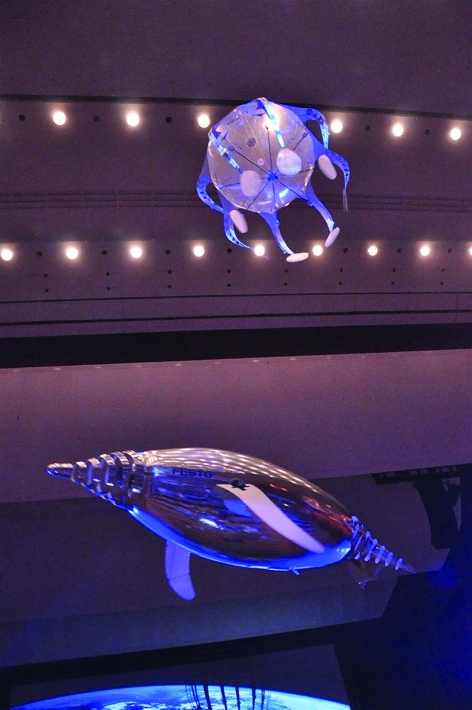It’s not every day that a giant helium-filled jellyfish swoops down on your head in a world-reknowned concert hall. Actually, it was last Sunday.
Science and technology took up residence in the Royal Festival Hall last week, when the Royal Society’s Summer Festival took over the South Bank of the Thames with an exhibition and a series of events. Cultish American band They Might Be Giants performed a special family show of their album of science-themed children’s songs; it was packed to the rafters. A flock of life-size pterosaur models was suspended over the terrace. In the huge public space beneath the auditorium, a range of stalls from companies, universities and institutions were presenting their work: the subjects included Cambridge and Bristol Universities’ work with morphing materials in aerospace; the European Extremely Large Telescope, to be built in Chile; displays on plate techtonics and the latest research into the properties of water; conservation of bees in Britain and rare long-legged wolves in Ethiopia; detection of microbes; and the work of the Diamond Light Source. And in the auditorium itself, Festo’s latest robotics concepts, two AirPenguins and an AirJelly, were gracefully flying around to the accompaniment of moody lighting and projections of the sun, moon and planets.

A better demonstration of the power of public engagement you couldn’t hope to see. Although the place was swarming with children and young people, there were also many adults; and the stalls were manned with people who earn their living at science and engineering. This wasn’t just an effort to engage the children, which can often give the impression that science is something to fascinate kids but which can be safely given up in later years: there was a real effort here to present science in the context of technology, as something that not only pervades our lives but is engaging on an adult scale; that it’s something you can do for a living. It’s what real people do.
The engineers from Festo were surrounded with people asking questions as their translucent creations flapped and soared silently overhead. As a demonstration of technology which is normally at home in the world of industrial automation, forming the grips for industrial robots — with the best will in the world, not something which is likely to engage many people outside their field — the flying penguins and jellyfish were a triumph.
Chatting with some of the people on the exhibition stalls, it seems that the ten-day event has attracted consistent interest. The EELT representatives, who were showing a 3D animation of the proposed telescope design, told me that they’d had as many questions about the engineering of the telescope as the astronomy, which usually grabs the headlines. The Cambridge stand was doing a brisk trade in ingenious origami versions of morphing structures.
It wouldn’t be surprising to find that, in a few years’ time, a considerable number of young people are inspired by the event to find careers in technology — and their families will have a good idea exactly what they’re doing and why they’re doing it. And it shows that public engagement, well designed and well considered, not only really works, but should be an integral part of the work of every institution involved in engineering.










Water Sector Talent Exodus Could Cripple The Sector
Maybe if things are essential for the running of a country and we want to pay a fair price we should be running these utilities on a not for profit...